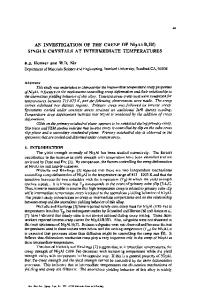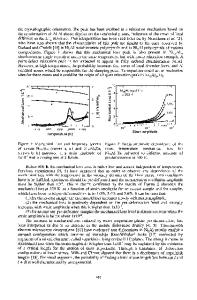The Effect of Prestrain on Deformation of Ni 3 Al Single Crystals
- PDF / 1,792,731 Bytes
- 7 Pages / 420.48 x 639 pts Page_size
- 111 Downloads / 330 Views
THE EFFECT OF PRESTRAIN ON DEFORMATION OF Ni3AI SINGLE CRYSTALS W.E. Dowling, Jr. and R. Gibala Department of Materials Science and Engineering, The University of Michigan, Ann Arbor 48109 ABSTRACT Prestrain of bcc metals at temperatures T>0.2Tm decreases the flow stress at lower temperatures (T 0.2 Tmi, where the mobilities of screw and non-screw dislocations are essentially equal. The introduction of such a mixed dislocation array by prestraining at the higher temperatures affords plastic flow at reduced stresses at low temperatures up to plastic strains at which the non-screw dislocations are essentially all exhausted into the screw orientation. To achieve larger plastic strains requires deformation at stress levels dictated by the mobility of the screw dislocation substructure. On the other hand, low temperature prestrain does not appreciably alter the high temperature flow stress because the screw-dominated dislocation substructure has appreciable mobility at the higher temperatures. In the present paper, we examine the effects of prestrain at relatively low or high temperatures on the subsequent plastic flow of Ni3Al at high or low temperatures, respectively. Starting at temperatures below 25'C (low0 temperatures), Ni 3AI exhibits a large positive temperature dependence to approximately 600 C - 700'C (high temperatures) which is associated with the thermally activated cross slip of screw dislocations from octahedral to cube planes. The screw dislocation is immobilized by the cross slip process because of its low mobility on the cube plane. As the temperature increases, larger stresses are required for plastic flow until mechanical testing is done at sufficiently high temperatures (above the peak temperature) at which cube slip by screw dislocation motion is easily thermally activated. By contrast, at low temperatures, edge and screw dislocations have similar mobilities and there exists only a very small negative temperature dependence of the flow stress in the temperature regime. Thus, prestrain experiments involving these relatively low and high temperatures offer significant insight into the dislocation dynamics of Ni3 Al and other L1 2 ordered alloys in a manner not previously examined. Mat. Res. Soc. Symp. Proc. Vol. 133. i1989 Materials Research Society
210
MATERIALS AND PROCEDURES The Howmet Turbine Component Corporation provided cast Ni-rich Ni 3AI single crystals of two compositions as shown in Table 1. Heat A was intentionally alloyed with boron and heat B was alloyed with B + Hf; all other elements were impurities. The intended composition was a Hf + Al content of 24 at% with 0.2 at% B. The 12.5 mm diameter x 150 mm long crystals were homogenized at 1225°C for 50 hrs. Approximately 25 mm long segments were cut from the crystal ends and 3.2 mm diameter rods were spark machined on a wire EDM unit. The rods were centerless ground to 3 mm diameter and electropolished to a final diameter of about 2.75 mm in 2:1 methanol:nitric acid at -20'C and 6 volts. The orientation of the rods was determined by th
Data Loading...











